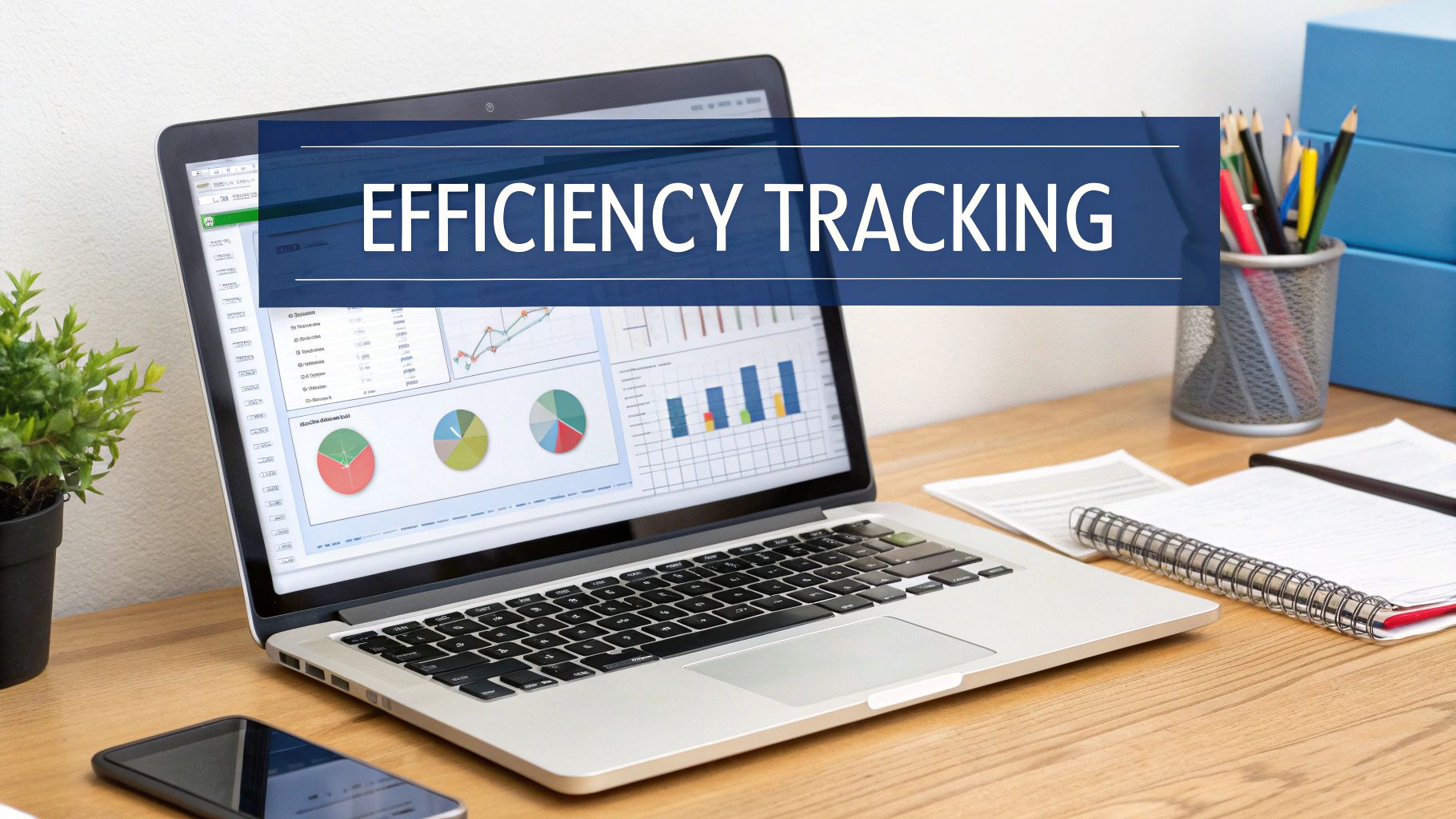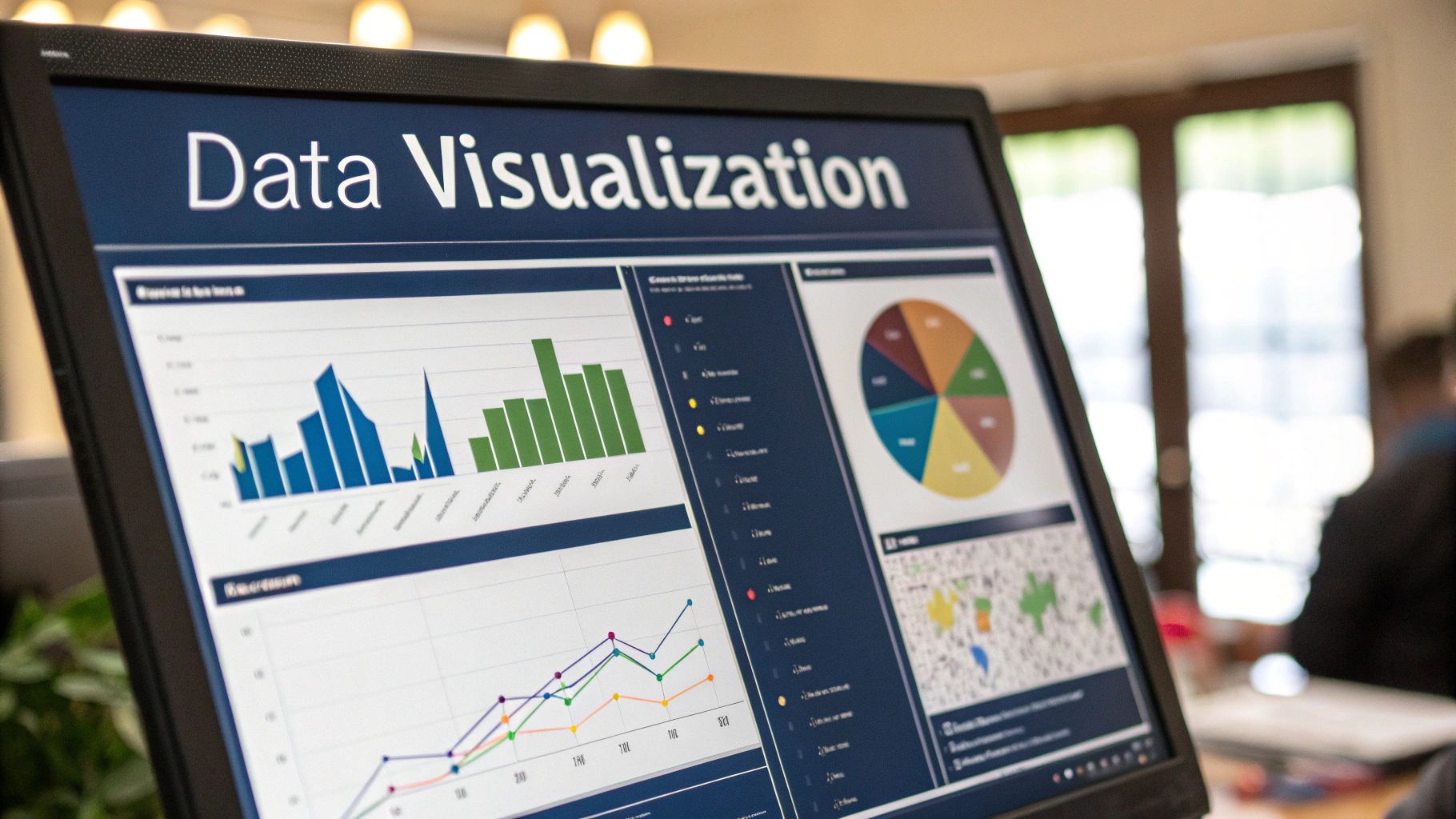Top Productivity Measurement Tools: A Complete Guide to Tracking Team Performance
Understanding Modern Productivity Measurement

Measuring team productivity today requires looking beyond simple time tracking to gain real insights into performance. Basic metrics like completed tasks and logged hours don't tell the full story, especially for knowledge work where output isn't easily counted. Getting meaningful data about how teams actually perform needs a more thoughtful approach.
The Pitfalls of Traditional Metrics
Old-school productivity tracking often misses what really matters - quality, efficiency, and business impact. For instance, rushing through tasks can lead to mistakes that require fixes later, hurting client satisfaction and actual productivity. Too much focus on hours worked can push people to just be present rather than productive, leading to burnout. That's why companies need proper productivity measurement tools to get the full picture.
Redefining Success: Quality Over Quantity
Smart teams now focus on measuring outcomes instead of just output. This means picking key performance indicators (KPIs) that connect directly to business goals. For example, sales teams might track deal values and conversion rates rather than just the number of calls made. This ensures everyone works on what truly drives business growth.
Looking back at how productivity measurement evolved provides helpful context. A key milestone came in 1976 when the U.S. Bureau of Labor Statistics started publishing quarterly data on labor productivity, hourly compensation, and labor costs. This was a major step toward more detailed tracking across different business sectors. Find more detailed statistics here
Building a Motivational Framework
Good productivity measurement does more than collect data - it helps teams stay motivated and engaged. Being open about how performance is measured and showing people how their work fits into bigger goals keeps employees invested. Regular constructive feedback based on performance metrics helps build a culture where people want to keep improving.
Moving beyond basic tracking to understand what truly drives productivity helps organizations make better decisions and use resources wisely. This creates a more effective and satisfying work environment for everyone. The next critical step is selecting and implementing the right tools to measure productivity in meaningful ways.
Choosing the Right Productivity Measurement Tools for Your Team

Picking productivity tools can be challenging with so many options available. The key is to match tools to your team's specific needs and work style. By examining real-world examples and focusing on essential features, you can select tools that drive meaningful improvements.
Key Features to Consider
Good productivity tools should give you clear data and help you take action. Look for these core capabilities that support effective team performance:
- Goal Setting and Tracking: Tools need to support setting and monitoring SMART goals (Specific, Measurable, Achievable, Relevant, Time-bound). This provides visibility into both individual and team progress.
- Time Management: Features for tracking time, managing tasks, and integrating with project tools help teams stay focused and hit deadlines effectively.
- Team Communication: The best tools connect seamlessly with your existing communication platforms or include built-in messaging to keep information flowing.
- Reports and Analysis: Look for strong analytics that highlight patterns, identify bottlenecks, and measure results. Key metrics like engagement times help gauge team performance.
- Flexibility: Choose tools that adapt to your workflow through customizable dashboards, reporting options, and integration with your current software.
Comparing Different Tool Types
Teams typically need a mix of tools to cover different aspects of productivity:
- Personal Task Tools: Todoist and Asana help individuals organize work and track personal progress.
- Project Platforms: Trello and Monday.com excel at team project tracking and task management.
- Time Trackers: Toggl Track and Clockify give detailed insights into how time is spent.
- Performance Systems: Lattice and BambooHR combine performance tracking with employee development features.
Building a Comprehensive Measurement System
Most successful teams use multiple complementary tools rather than a single solution. For example, combining project management software with time tracking and team chat creates a complete productivity system. The key is choosing tools that work well together and meet your specific needs. This approach provides accurate productivity data while avoiding feature overload. Focus on gathering relevant metrics that help your team improve and grow.
Implementing Tools That Teams Actually Use
Building successful productivity measurement systems goes beyond selecting software. Teams need to see these tools as helpful resources rather than burdensome requirements. Here's how to implement productivity tools effectively.
Creating Buy-In From Day One
When introducing new tools, start by clearly explaining the purpose and benefits for the team. Show how data insights can improve workflows, reduce workloads, and better recognize individual contributions. This helps position productivity tracking as a collaborative improvement effort.
Get the team involved early in choosing tools. When team members have input in tool selection, they feel ownership and are more likely to embrace the change. Consider testing different options and gathering team feedback before making a final decision.
Establishing Clear Measurement Protocols
Define clear guidelines for using the selected tools, including what metrics matter, how they're calculated, and how the data will be applied. Transparency builds trust - teams are more engaged when they understand how measurement connects to their goals. Set expectations upfront to prevent confusion.
Building a Culture of Value
Position productivity measurement as a way to celebrate wins and identify growth opportunities, not as surveillance. Share data regularly with the team to highlight positive trends and accomplishments. This reinforces that tools exist to help teams improve.
Use data constructively by identifying bottlenecks and working together on solutions. Focus measurement discussions on collaborative problem-solving rather than individual performance critiques.
Overcoming Common Challenges
New tool adoption often faces initial resistance. Address concerns proactively through open dialogue. Provide comprehensive training and ongoing support so everyone feels comfortable using the tools effectively.
Data accuracy is another key challenge. Create clear protocols for consistent usage and regularly review data quality. Quickly fix any discrepancies to maintain confidence in the measurements.
By making data a shared resource for improvement, organizations can transform productivity tracking from a source of stress into a valuable asset. Taking time to thoughtfully implement tools with team input leads to better adoption and more meaningful insights to drive team success.
Turning Productivity Data into Action

Getting productivity data is just the start - the real value comes from using that information to improve how teams work. This means going beyond just collecting numbers to finding meaningful insights that drive better performance.
Frameworks for Data Analysis
Start by clearly defining what you want to achieve. What specific improvements are you looking for? Your goals will help determine which metrics matter most. For example, if you need faster project completion, focus on analyzing task timing and bottlenecks.
Two key frameworks can help structure your analysis. The SMART goals framework ensures objectives are Specific, Measurable, Achievable, Relevant and Time-bound. Key Performance Indicators (KPIs) provide concrete metrics to track progress toward specific targets. Both approaches help teams stay focused on what matters.
Visualizing Productivity Data
Numbers alone can be hard to grasp. Visual formats like charts and dashboards make it easier to spot important patterns and trends. A simple line graph can show productivity changes over time, while bar charts compare performance across teams.
Good visualizations do more than look nice - they make complex data understandable at a glance. A well-designed dashboard highlights the most important metrics so you can quickly see what needs attention. Visual data also helps when sharing findings with others and building support for changes.
Implementing Data-Driven Changes
Once you identify areas for improvement, create specific action plans. This could mean adjusting workflows, providing training, or shifting resources. For example, if data shows certain tasks consistently take too long, investigate why and optimize those processes.
The key is to involve the team in making changes. Share findings, get their input, and develop solutions together. This creates buy-in and ensures changes are practical. Start with quick wins to build momentum and show the value of data-based decisions.
Predicting Potential Issues and Developing Targeted Solutions
Use your data to get ahead of problems before they happen. Look for patterns in historical data - like rising error rates at certain times - and take preventive action.
This requires ongoing monitoring and analysis. Review data regularly, identify emerging trends, and adjust strategies as needed. Using productivity tools can help by providing easy access to data, letting you focus on analysis rather than data collection. This helps teams spot issues early and make improvements faster.
The cycle of measuring, analyzing, implementing changes, and refining approaches helps teams consistently improve. By turning data into action, organizations can build a culture of continuous improvement and help teams perform at their best.
Creating a Culture of Productive Well-being
Success with productivity tools comes from creating an environment focused on both performance and well-being. The key is using productivity measurement tools as resources that help teams grow and improve, rather than as monitoring systems that create stress and anxiety.
Building Transparency and Trust
Clear communication is essential when implementing productivity tools. Teams need to understand what metrics are being tracked and how the data will be used to improve workflows. When everyone knows the purpose behind measurement, they're more likely to participate positively.
Share specific examples of how data insights can highlight opportunities to work more efficiently. Position productivity tracking as a collaborative effort that benefits both individuals and the organization.
Supporting Professional Growth
The data from productivity tools provides valuable self-awareness. Time tracking helps team members understand their work patterns and identify ways to improve focus. Used constructively, this information empowers people to manage their time better without feeling pressured.
Goal-setting features also enable individuals to connect their daily work to larger objectives. This gives people more control over their professional development and encourages proactive engagement.
Preventing Burnout and Prioritizing Well-being
While productivity matters, pushing too hard leads to burnout and worse results over time. Teams should use productivity data to spot early warning signs like excessive overtime or task overload. This allows managers to adjust workloads before problems arise.
The goal is finding a sustainable balance between high performance and individual well-being. Regular check-ins about workload and stress levels help maintain this equilibrium.
Addressing Privacy Concerns and Maintaining Ethical Measurement
Clear guidelines around data privacy build trust. Teams need to know exactly what information is collected, how it's protected, and who can access it. Focus measurement on job-relevant metrics rather than personal details.
Keep the emphasis on using data to support team success rather than monitor individuals. When productivity tools are positioned as helpful resources rather than surveillance, teams engage more willingly and positively with measurement efforts.
Preparing for the Future of Performance Measurement

Teams need to stay current with new methods and tools to effectively measure performance. Understanding how technologies like AI, machine learning, and integrated platforms are changing performance tracking helps teams work smarter and achieve better results.
The Rise of AI and Machine Learning
AI and machine learning tools are making performance measurement more precise and insightful. These technologies can spot patterns in team data that humans might overlook, helping identify bottlenecks and areas for improvement. This gives managers better information for making decisions about resources and processes.
Machine learning can also analyze past performance to forecast future trends. Teams can address potential issues early, before they impact results. This shift from reactive to proactive management leads to better outcomes.
Integrated Workplace Platforms
Performance measurement is becoming more connected through unified workplace platforms. These systems bring together project management, team communication, and performance tracking in one place. Teams no longer need multiple separate tools to access key information.
Having everything integrated provides clearer insights into how different factors affect performance. Teams can easily see connections between productivity metrics, project status, and communication patterns.
Maintaining a Human-Centered Approach
While technology is important, the human element remains essential. Performance measurement tools should support teams, not control them. The goal is using data to help people work better together and create positive work environments.
This means involving teams when choosing new tools, being open about how data is collected and used, and focusing on growth rather than just evaluation. A human-centered approach ensures technology helps rather than hinders team success.
Future-Proofing Your Productivity Strategy
To prepare for changes in performance measurement, teams should commit to learning and adapting. This includes evaluating new technologies, testing different approaches, and being open to change.
Understanding your team's specific needs and goals is crucial. When your measurement approach aligns with business objectives, you'll choose the right tools and metrics to drive real improvements. Taking a thoughtful, proactive approach helps teams succeed both now and in the future.
Ready to create and manage documents faster? Whisperit uses AI to help professionals work up to twice as efficiently. Learn more at Whisperit.ai.